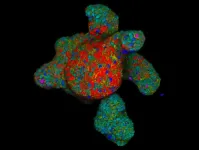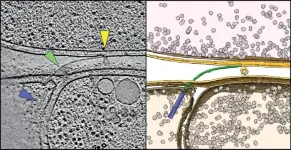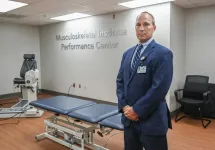(Press-News.org) Studies of chemicals in our blood typically capture only a small and unknown fraction of the entire chemical universe. Now, a new approach aims to change that. In a study involving blood samples of pregnant women collected between 2006 and 2008, researchers report having quantified many complex mixtures of chemicals that may pose neurotoxic risks, even when the individual chemicals were present at seemingly harmless levels. “The quantification of 294 to 473 chemicals in plasma is a major improvement compared with the usual targeted analysis focusing on only few selective analytes,” wrote the authors. They note that screening studies are often limited to fewer than 100 identified chemicals. Their work represents a novel approach to biomonitoring the “toxic exposome.” The human exposome encompasses all the environmental factors a person experiences throughout their life – such as what they eat, where they live, and chemicals they interact with. Among these myriad factors, humans are exposed to hundreds, if not thousands, of chemicals daily. The toxic exposome has become particularly concerning as rising chemical production has been linked to an increase in disease and developmental disorders, especially in children exposed to endocrine-disrupting and neurotoxic substances. Although human biomonitoring (HBM) studies aim to measure the chemical burden in biological samples like blood and urine, they often focus on a limited set of known chemicals and overlook the complexity and variability of the entire toxic exposome. Moreover, few studies have considered the toxicity of chemical mixtures in the body.
To address these limitations, Georg Braun and colleagues adapted a bioassay originally developed for water quality assessment to characterize the chemical load and mixture effects of chemicals present in the blood. Combining high-resolution chemical analysis with a high-throughput in vitro assay for neurotoxicity, blood plasma samples of 624 pregnant women from the German LiNA cohort were evaluated. The approach allowed the authors to detect and quantify 294 out of 1199 target chemicals. They found that each participant harbored a complex mixture of organic chemicals, with between 5 and 146 chemicals detected per individual, categorized into six groups: industrial chemicals, pesticides, pharmaceuticals, personal care products, food-related, and endogenous compounds. Many of the detected chemicals were shown to interfere with neurite development. Experimental testing of simulated chemical mixtures confirmed that complex chemical cocktails act additively to produce neurotoxic effects, even if concentrations were below individual chemicals’ toxic effect thresholds. Chemicals attributed to industry and consumer goods were the major drivers of neurotoxic effects in mixtures.
“These effects are not of any immediate health concern for pregnant women and their babies. The concentrations we detected reflect typical levels detected in healthy adults worldwide; we just quantified many more chemicals and could therefore experimentally demonstrate the hypothesized mixture effects,” said Beate Escher, a study coauthor. “It is still worrisome to realize that we find traces of almost every persistent chemical we have produced in the last 100 years, as well as many of the degradable but highly used present-day chemicals. If we carry on to produce and emit chemicals at the current rate into the environment, the burden of chemicals will eventually increase to levels that will cause effects on health.”
END
A new approach to capturing complex mixtures of organic chemicals in blood, evaluated in pregnant women
Summary author: Walter Beckwith
2024-10-17
ELSE PRESS RELEASES FROM THIS DATE:
Gut instincts: Intestinal nutrient sensors
2024-10-17
A multi-institutional group of researchers led by the Hubrecht Institute and Roche’s Institute of Human Biology has developed strategies to identify regulators of intestinal hormone secretion. In response to incoming food, these hormones are secreted by rare hormone producing cells in the gut and play key roles in managing digestion and appetite. The team has developed new tools to identify potential ‘nutrient sensors’ on these hormone producing cells and study their function. This could result in new strategies to interfere with the release of these hormones and provide avenues for the treatment of a variety of metabolic or gut motility disorders. The work will be presented ...
Catching prey with grappling hooks and cannons
2024-10-17
Countless bacteria call the vastness of the oceans home, and they all face the same problem: the nutrients they need to grow and multiply are scarce and unevenly distributed in the waters around them. In some spots they are present in abundance, but in many places they are sorely lacking. This has led a few bacteria to develop into efficient hunters to tap into new sources of sustenance in the form of other microorganisms.
Although this strategy is very successful, researchers have so far found only a few predatory bacterial species. One is the soil bacterium Myxococcus xanthus; ...
Effects of chemical mixtures: Neurotoxic effects add up
2024-10-17
"In our everyday lives, we are exposed to a wide variety of chemicals that are distributed and accumulate in our bodies. These are highly complex mixtures that can affect bodily functions and our health," says Prof Beate Escher, Head of the UFZ Department of Cell Toxicology and Professor at the University of Tübingen. "It is known from environmental and water studies that the effects of chemicals add up when they occur in low concentrations in complex mixtures. Whether this is also the case in the human body has not yet been sufficiently investigated - this is precisely where our study comes in."
The extensive research work was based on over 600 blood samples from ...
Mpox in Africa was neglected during the previous outbreak, and requires urgent action and investment by leaders now to prevent global spread
2024-10-17
Mpox in Africa was neglected during the previous outbreak, and requires urgent action and investment by leaders now to prevent global spread, claim experts from The Independent Panel for Pandemic Preparedness and Response, ex-NZ Prime Minister Helen Clark, former Liberian President and Nobel Peace Prize winner Ellen Johnson Sirleaf, and other global health specialists.
####
Article URL: https://journals.plos.org/globalpublichealth/article?id=10.1371/journal.pgph.0003714
Article Title: Mpox: Neglect has led to a more dangerous virus now spreading across borders, harming and killing people. Leaders must take action to stop mpox now
Author Countries: ...
A new era of treating neurological diseases at the blood-brain-immune interface
2024-10-17
SAN FRANCISCO—The question of what causes complex neurological diseases such as Alzheimer’s or multiple sclerosis continues to confound scientists and doctors, with the unknowns standing in the way of early diagnoses and effective treatments.
Even among identical twins who share the same genetic risk factors, one may develop a particular neurological disease while the other does not.
That’s because unlike diseases such as cystic fibrosis or sickle-cell anemia, which are caused by a single gene, most neurological disorders are associated with many—sometimes hundreds—of rare genetic variants. ...
Astronomers detect ancient lonely quasars with murky origins
2024-10-17
A quasar is the extremely bright core of a galaxy that hosts an active supermassive black hole at its center. As the black hole draws in surrounding gas and dust, it blasts out an enormous amount of energy, making quasars some of the brightest objects in the universe. Quasars have been observed as early as a few hundred million years after the Big Bang, and it’s been a mystery as to how these objects could have grown so bright and massive in such a short amount of cosmic time.
Scientists have proposed that the earliest quasars sprang from overly dense ...
New study highlights the dangers of handheld cellphone use among teen drivers
2024-10-17
PHILADELPHIA (October 17, 2024) – A new study, conducted by a group of researchers led by Penn Nursing and Perelman School of Medicine and funded by the Centers for Disease Control, found a strong association between handheld cellphone use and risky driving behaviors among newly licensed teen drivers. The study, published online first in JAMA Open, used a smartphone telematics application to track the driving habits of hundreds of teens and identify potential safety risks.
The investigation found that teens who used their cellphones while driving were significantly more likely to engage in risky driving behaviors, such as hard braking and rapid acceleration. These behaviors can ...
Part of the GBHSH community in Spain uses doxycycline to prevent sexually transmitted diseases
2024-10-17
The increasing incidence of sexually transmitted bacterial infections (STIs) is a major public health problem worldwide. Currently, among the therapies being studied is the use of the antibiotic doxycycline as a method of post-exposure prophylaxis after unprotected sex — known as DoxyPEP. Now, the University of Barcelona and the NGO Stop have carried out the first study in Spain on the use of DoxyPEP as a preventive strategy among the gay, bisexual and other men who have sex with men (GBHSH) community in Spain.
“The results suggest that, although medical and scientific associations rarely endorse the community use of DoxyPEP as a prevention strategy, ...
Researchers at Wake Forest University School of Medicine receive $4.5 million grant from Department of Defense to study neck injuries
2024-10-17
CHARLOTTE, N.C. – Oct. 17, 2024 – Researchers at Wake Forest University School of Medicine have received a three-year, $4.5 million grant from the Department of Defense to study cervical spine injuries in military personnel.
Musculoskeletal injuries, such as those that occur to the cervical spine (neck), are problematic for military personnel. This is especially true for military personnel who must perform missions in demanding environments with head-supported mass. This head-supported mass includes the baseline protective helmet, communications, specialized night vision technology and other attachments.
“These injuries can lead to a significant number of lost-duty ...
Study suggests a healthy diet may help keep low grade prostate cancer from progressing to more dangerous states during active surveillance
2024-10-17
In a peer-reviewed study believed to be the first of its kind published, a research team led by Johns Hopkins Medicine provides scientific evidence that a healthy diet may reduce the chance of low risk prostate cancer progressing to a more aggressive state in men undergoing active surveillance — a clinical option in which men with lower risk cancer are carefully monitored for progression in lieu of treatments that could have undesired side effects or complications.
The findings are reported today in the journal JAMA Oncology.
“Many men diagnosed with low grade prostate cancer are interested in changes they can ...
LAST 30 PRESS RELEASES:
Ticking time bomb: Some farmers report as many as 70 tick encounters over a 6-month period
Turning garden and crop waste into plastics
Scientists discover ‘platypus galaxies’ in the early universe
Seeing thyroid cancer in a new light: when AI meets label-free imaging in the operating room
Neutrophil-to-lymphocyte ratio may aid risk stratification in depressive disorder
2026 Seismological Society of America Annual Meeting
AI-powered ECG analysis offers promising path for early detection of chronic obstructive pulmonary disease, says Mount Sinai researchers
GIMM uncovers flaws in lab-grown heart cells and paves the way for improved treatments
Cracking the evolutionary code of sleep
Medications could help the aging brain cope with surgery, memory impairment
Back pain linked to worse sleep years later in men over 65, according to study
CDC urges ‘shared decision-making’ on some childhood vaccines; many unclear about what that means
New research finds that an ‘equal treatment’ approach to economic opportunity advertising can backfire
Researchers create shape-shifting, self-navigating microparticles
Science army mobilizes to map US soil microbiome
Researchers develop new tools to turn grain crops into biosensors
Do supervised consumption sites bring increased crime? Study suggests that’s a myth
New mass spec innovation could transform research
Maternal nativity, race, and ethnicity and infant mortality in the US
Migration-related trauma among asylum seekers exposed to the migrant protection protocols
Jupiter’s moon Europa has a seafloor that may be quiet and lifeless
SwRI upgrades nuclear magnetic resonance laboratory for pharmaceutical R&D
House sparrows in northern Norway can help us save other endangered animals
Crohn's & Colitis Foundation survey reveals more than 1/3 of young adults with IBD face step therapy insurance barriers
Tethered UAV autonomous knotting on environmental structures for transport
Decentralized social media platforms unlock authentic consumer feedback
American Pediatric Society announces Vanderbilt University School of Medicine as host institution for APS Howland Visiting Professor Program
Scientists discover first method to safely back up quantum information
A role for orange pigments in birds and human redheads
Pathways to net-zero greenhouse gas emissions for Southeast Asia
[Press-News.org] A new approach to capturing complex mixtures of organic chemicals in blood, evaluated in pregnant womenSummary author: Walter Beckwith








